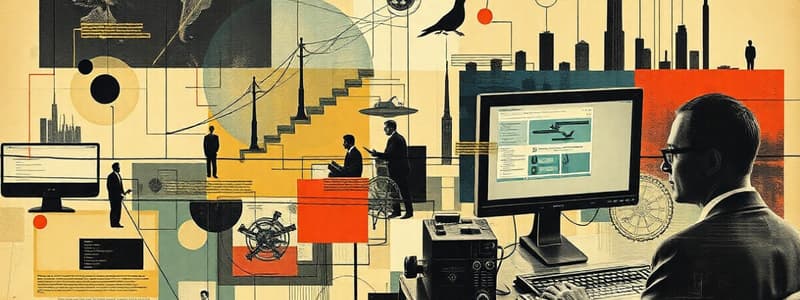Podcast
Questions and Answers
Which of the following is NOT considered a component of an Enterprise Information System?
Which of the following is NOT considered a component of an Enterprise Information System?
- Human interactions with data
- Financial performance metrics (correct)
- Hardware for data management
- Rules and guidelines for information flow
Which group of items can be classified as hardware in an Enterprise Information System?
Which group of items can be classified as hardware in an Enterprise Information System?
- Folders, papers, and pencils (correct)
- Data storage solutions and cloud services
- Networking equipment and servers
- Software applications and licenses
Who plays a crucial role in an Enterprise Information System?
Who plays a crucial role in an Enterprise Information System?
- Only IT specialists and data analysts
- Individuals involved in information handling at various levels (correct)
- Only upper management executives
- External consultants and advisors
What misconception might individuals have about the hardware of an Enterprise Information System?
What misconception might individuals have about the hardware of an Enterprise Information System?
Which factor is most critical for designing an effective Enterprise Information System?
Which factor is most critical for designing an effective Enterprise Information System?
Why might someone underestimate the importance of low-tech hardware in an Enterprise Information System?
Why might someone underestimate the importance of low-tech hardware in an Enterprise Information System?
What historical aspect demonstrates the long-standing presence of Enterprise Information Systems?
What historical aspect demonstrates the long-standing presence of Enterprise Information Systems?
What description fits the data within an Enterprise Information System?
What description fits the data within an Enterprise Information System?
In an Enterprise Information System, what does the flow of information typically involve?
In an Enterprise Information System, what does the flow of information typically involve?
Flashcards
Enterprise Information System
Enterprise Information System
A set of rules, resources, and procedures that manage the flow of information within an organization.
Information Flow Rules
Information Flow Rules
The guidelines, rules, and protocols that determine how information enters, is stored, used, and exits an organization.
Organizational Data
Organizational Data
All the data collected, stored, used, and disseminated by an organization.
People in Information Systems
People in Information Systems
Signup and view all the flashcards
Information System Hardware
Information System Hardware
Signup and view all the flashcards
Information System Hardware
Information System Hardware
Signup and view all the flashcards
Low-Tech Information Hardware
Low-Tech Information Hardware
Signup and view all the flashcards
Ancient Information Systems
Ancient Information Systems
Signup and view all the flashcards
Information Flow
Information Flow
Signup and view all the flashcards
Types of Information System Components
Types of Information System Components
Signup and view all the flashcards
Study Notes
Enterprise Information System Definition
- An Enterprise Information System (EIS) is the combined rules, resources, and procedures determining information flow within an organization. This includes how information enters, is stored/used, and leaves the organization.
Components of an EIS
- Rules, Guidelines, and Protocols: The established procedures for information flow within the organization – essentially everything dictating how information moves.
- Information (Data): All data collected, stored, used, and shared by the organization.
- Human Resources: All individuals involved in collecting, storing, using, or disseminating information within the organization.
- Hardware: All physical equipment used to collect, store, use, or disseminate information. This can include computers, but also physical items like folders, papers, and pencils. Even sticks & clay tablets from earlier times were hardware.
Importance of Hardware Across Time
- EIS hardware isn't necessarily limited to high-tech items like computers.
- Organizations from the past, such as early Sumerian merchants, also had information systems with physical components such as sticks and clay tablets.
Studying That Suits You
Use AI to generate personalized quizzes and flashcards to suit your learning preferences.




